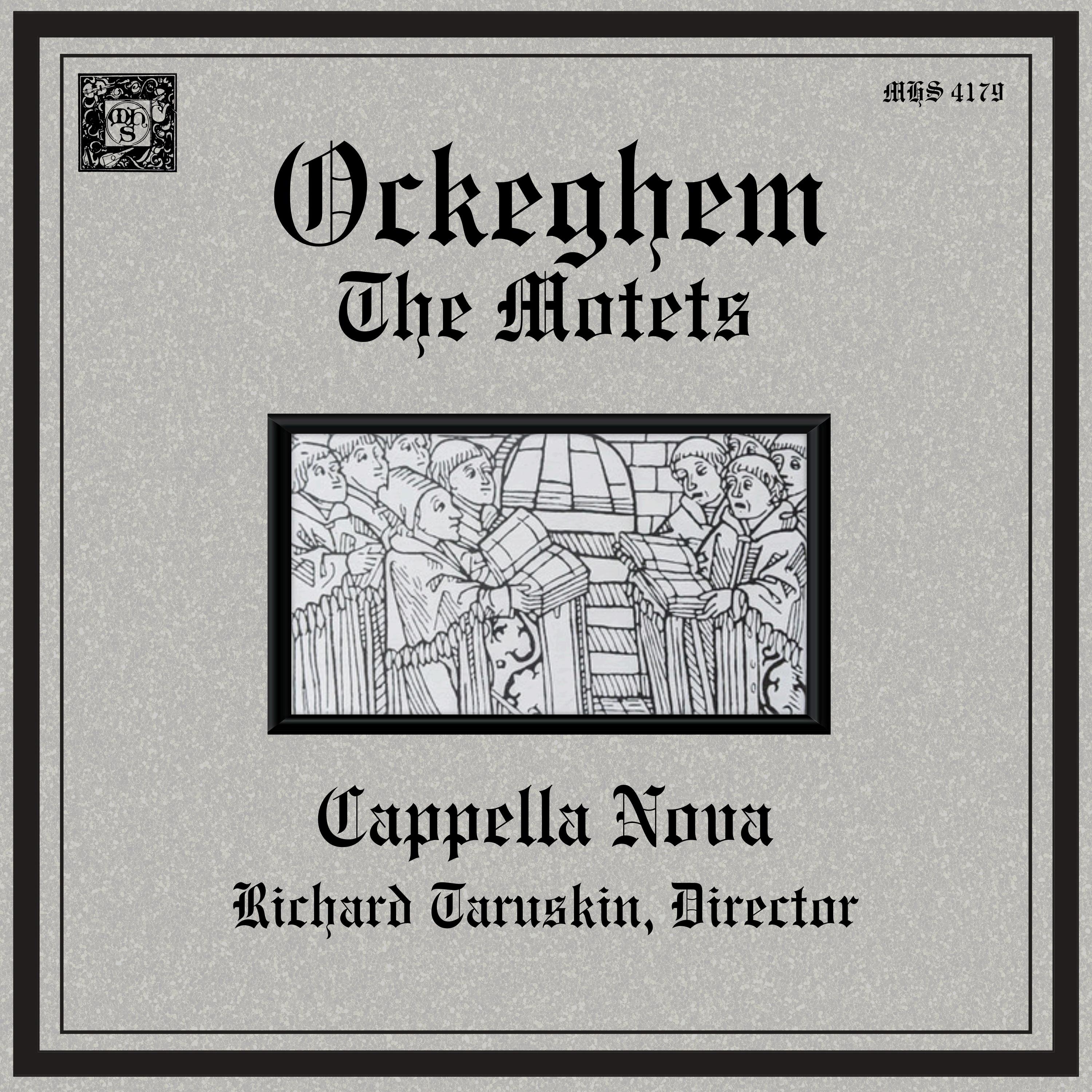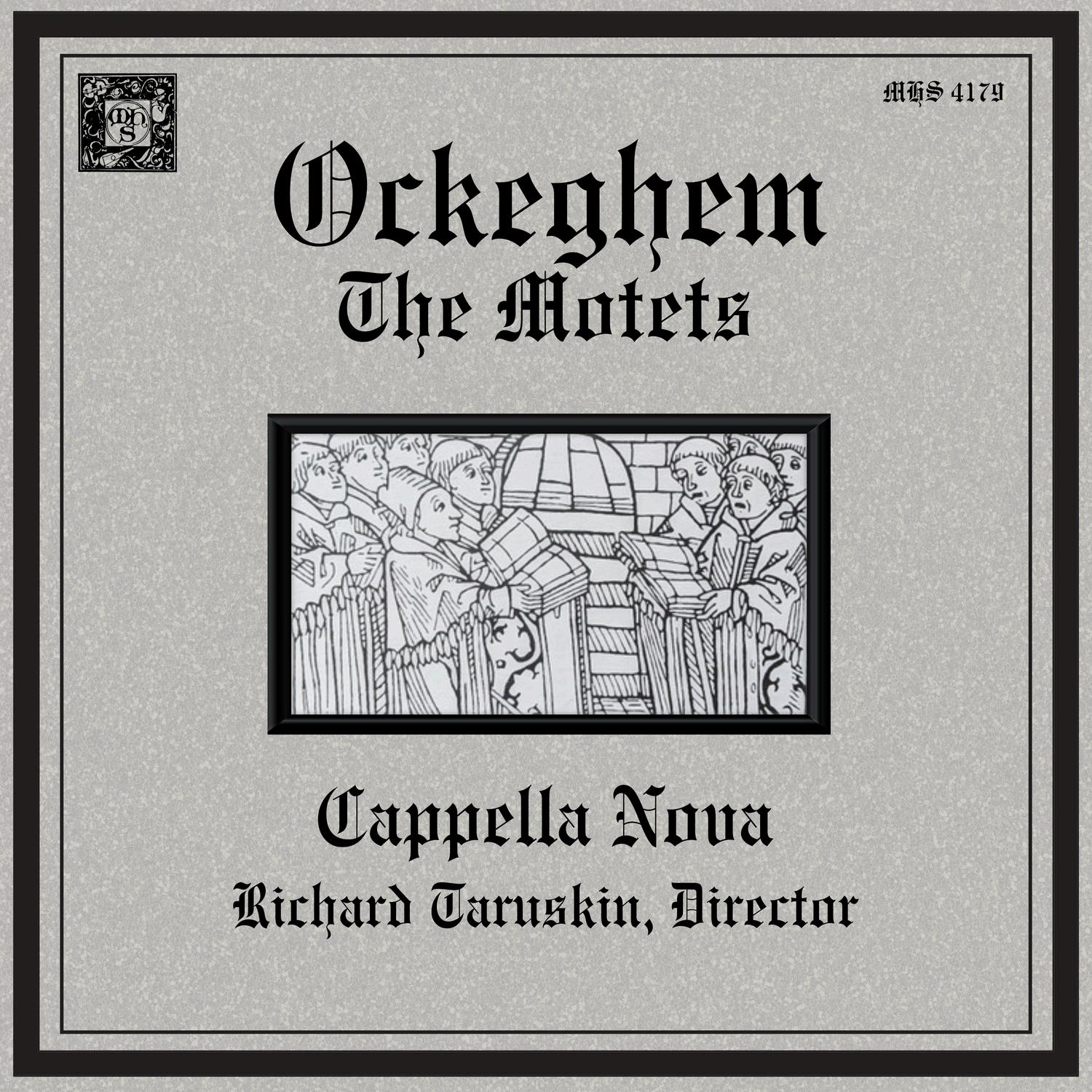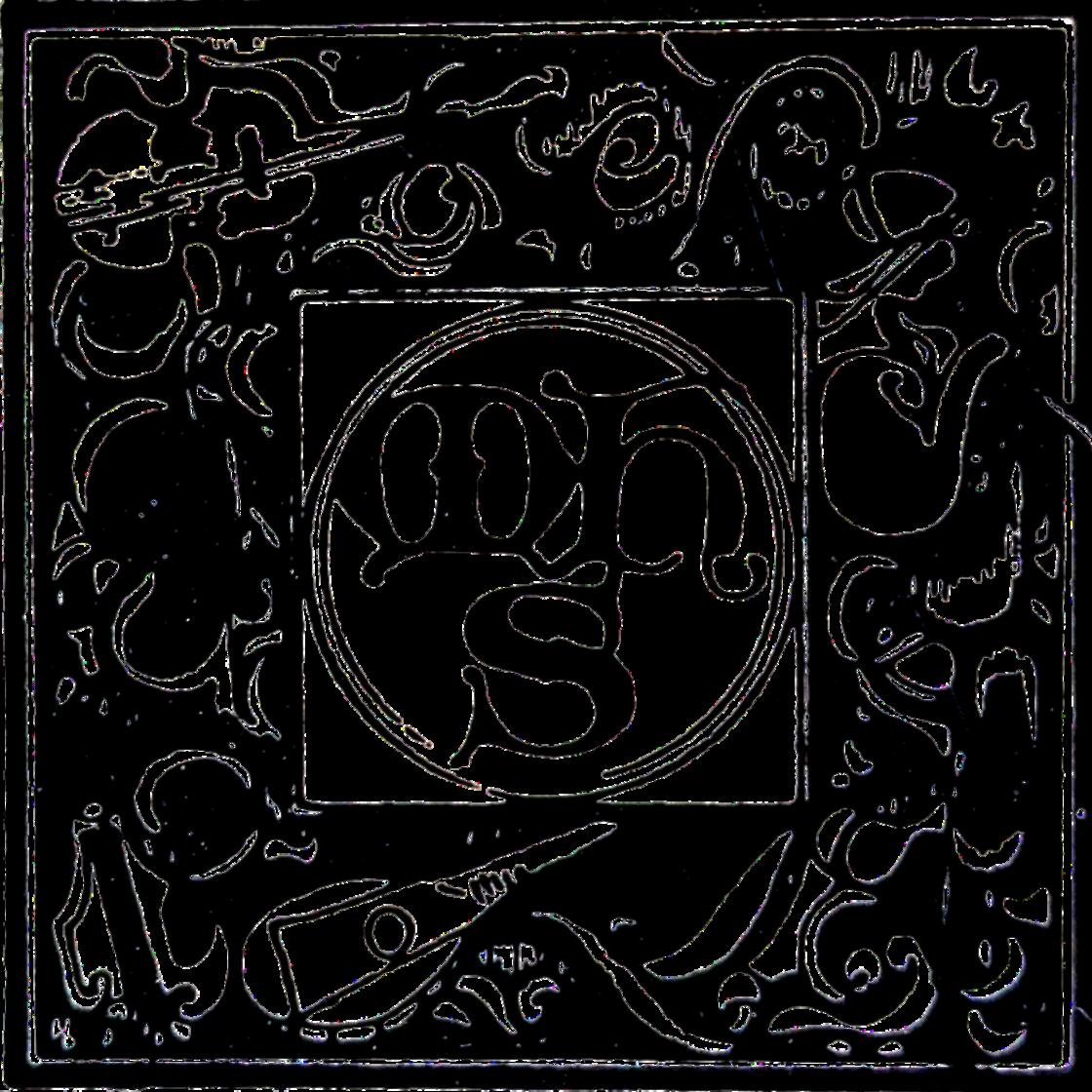

Johannes Ockeghem: Motets

1 BUSNOIS: In Hydraulis 06:34
2. Alma Redemptoris Mater 05:33
3. Intemerata Dei mater 07:42
4. Salve Regina (manuscript Cappella Sistena 42) 08:41
5. Salve Regina II (manuscript Cappella Sistina 46) 04:38
6. Ave Maria 03:29
7. Celeste beneficium (doubtful attribution to Ockeghem) 09:45
8. Gaude Maria (doubtful attribution to Ockeghem) 09:53

Ockeghem
The Motets

D
uring the 15th century, the genre of musical
composition known as motet underwent such a
thorough transformation that it would be virtualy
impossible to define the word in terms that applied
equally well to works so named written at the begin
ning of the period and at the end. Around 1400, the
motet, always the epitome of learned music, had
become a sort of musi cal monument. It was
conceived in purely architectonic terms: over the
foundation of a borrowed Gregorian chant cast as
it were in musical stone by a process of elaborate
rhyth mic patterning known then as “talea” and now
as “isorhythm, ” melodic lines-each carrying its own
text and hang intelligibility! Were vaulted and
buttressed in great sonic arches. In their extreme
complexity of design and rigidity of structure,
motets of this type gave expression to the final,
most impressive outburst of late medieval cosmic
speculation in tone: the apotheosis of the Platonic
ideal of music as the divinely ordained symbol of
the harmony of the spheres. Isorhythmic motets
celebrated great occasions, praised great cities, and honored great men of church and state. The last major practitioner of this somewhat archaic genre was Guillaume Dufay (d. 1474), who wrote, among others, three impressively grandiose specimens to commemorate events in the career of Pope Eugenius IV (reigned 1431-40).
By the middle of the century, elaborately constructivist techniques had largely passed over into the domain of the cyclic Mass, and the motet was reborn (the English, whose music was

luxuriantly in votive services And were surely known to all believers by heart.
Johannes Ockeghem (d 1497), Dufay’s Successor
as leading composer of Catholic church music in
the late 15th century, was heir to all these
traditions and developments, both musical and liturgical. This recording presents his entire extant legacy of motets (undoubtedly only a fraction of what he must have composed during his halfcentury career) with the exception of some
fragments and a mysterious composition entitled
Ut heremita solus (“Lonely as a Hermit"), which
Comes down to us shorn of its text. All but one of the seven motets are Marian (and even the
remaining work Celeste benei cium, is probably only an apparent exception, as will be explained. In their style and fac- ture, Ockeghem’s motets
adhere to the line established by Dufay’s Ave
Regina, while at the same time proclaiming their
Composer’s individuality in matters of texture and sonority: three of the motets are scored for five
Voice parts rather than the standard complement of four, and several exploit extreme tessituras. One in particular, Intemerata, is a prime example of the exploration of the low est depths of vocal range for which Ockeghem-known in his day as a bass singer as well as composer-was famed Many of Ockeghem's motets are found in choirbooks associated with the Papal chapel choir in Rome, testifying to his prestige as churchman and composer alike, as he him self never sang there.
And all of them display the effortless perfection of
form and rapt spirituality through whose magical combination, in the words of Desiderius Erasmus,
"the golden voice of Ockeghem caressed the ears of the angels, and swayed the hearts of men to their depths."
-Richard Taruskin
TEXTS AND NOTES ON THE WORKS
1 In praise of Ockeghem: In Hydraulis
(words and music by Antoine Busnois)
Source: Trent, Castello del Buon Consiglio, Ms. 91, f. 35-37 (music) Munich, Bayerische
Staatsbibliothek, Mus. Ms. 3154, f. 27-29 (text)
In hydraulis quondam Pythagora/ Admirante melos, phtongitates/Malleorum. Secutus aequora/Per
ponderum inaegquili tates/Advenit musae
qualitates./Epitritum ac emioliam,/Epogdoi duplam
perducunt./Nam tessaron pente
convenientiam/Nec non phtongum et pason
adducunt,/Monocordi dum genus conducunt.
Once Pythagoras, having wondered at the melodies
of water organs, and having attend ed to the pitches
made by hammers, discovered the ratio-properties
of the muse through the inequalities of weights.
These ratios are the epitritum (4:3), the emiolia
(3:2), the epogdoon (9:8) and the double proportion
(2:1). These produce the harmony of fourth, fifth,
tone and octave, while monochords complete the scale.

Haec Ockeghem, qui cunctis ecinis/Galliarum in regis aula,/Practicum propaginis/Arma cernens
quondam Jagora/Burgundiae ducis in patria,/Pro
Busnois, illustris comitis/De Chaulois indignum
musicum,/Saluteris tuis pro meritis/Tamquam
summum capias tro pheum,/Vale, verum instar
Orpheicem!
You, Ockeghem, who have understood the late
Pythagoras and are first among singers at the court
of the King of France, strengthen the practice of your progeny in the nation of the Duke of Burgundy.
On behalf of me. Busnois, unworthy musician of the
illustrious Count of Charolais, be saluted for your great merit, and may you take the highest trophy.
Flourish, true image of Orpheus!
Text emended and translated by Susan Hellauer
As a kind of preface to our program of Ockeghem
motets we present this tribute to the master—itself in the form of a motet- from his greatest colleague,
Antoine Busnois (d. 1492), who was to the court and chapel of the Duchy of Burgundy what
Ockeghem was to those of France: “first singer”
(i.e., chiet musician and composer), as the text of the motet puts it. Ockeghem is compared with
Pythagoras, the legendary inventor of musi cal science, and with Orpheus, the semi godly musician who could move the shades of Hades with
his songvivid testimonials To Ockeghem’s preeminence in the eyes of contemporaries. Since
Busnois refers to his patron as the Count of
Charolais The motet must have been written
before Charles the Bold acceded to the ducal
throne in 1467. And since dedicatory motets like
this one probably arose from direct professional
contact. It has been suggested that In hydraulis
was composed in connection with the coronation
of Louis XI of France in 1461, when the whole
Burgundian court and its entourage visited Paris.
Since In hydraulis is a celebratory motet with a
“great man” as its object, and especially since its
text deals so conspicuously with musical “science, ”
it is not surprising that Busnois reverted in it
somewhat to the style and procedures of the old-
fashioned isorhythmic motet. The whole piece is
laid out over a series of repetitions in the tenor part
of a three-note pattern which, in its transposition,
sums up the “Pythagorean” pitch ratios the text
describes Moreover, the three-note motive is put
through a series of rhythmic alterations that
express the same ratios in terms of durations.
Meanwhile the three other voices carol away in the
most complex fashion-syncopations, lengthy melodic sequences, cross rhythms and accents
galore And so, despite the ostensibly hon oritic
purpose and the ostentatiously humble tone of the
motet’s text, one imagines that the real purpose of
the piece may well have been to astound the
assembled musicians of the French court with
Burgundian virtuosity. (Ockeghem seems to have
returned the “compliment” with the even more
spectacularly complex Ut heremita solus, which,
for carious reasons too lengthy to go into here,
might be a sort of companion piece to in hydraulis
with Busnois as its dedicatee).
Alma Redemptoris Mater
Source: Rome, Biblioteca Apostolica Vaticana, Ms.
Cappella Sistina 46, f. 115-17
Alma redemptoris mater/quae pervia caeli porta
manes,/et stella maris, succure cadeno ti/surgere
qui curat populo:/Tu quae genuistio natura
mirante,/tuum sanctum Genitorem
Mother beloved of the Savior, and Gate wide open of Heaven, Star of the Sea, bring help to the people
that weakens and wavers; O thou, whom marveling
Nature saw to bear the Creator within thee:
Virgo prius ac posterius, /Gabrielis ab ore sumens illud Ave,/peccatorum miserere Amen.
Virgin before and since, O thou to whom Gabriel kneeling, uttered his "Hail” , show pity to all sinners. Amen.
Tradition holds that the original chant melody of this Marian antiphon was composed in the eleventh century by the monk and musical theorist
Hermannus Contractus Abbot of Reichenau in
Switzerland (1013-54). In Ockeghem's setting, the melody is transposed up a fifth, liberally embellished in the manner of the cantilena, and assigned to the alto voice rather than the more conventional tenor. The unusually high range thus achieved combines with an exceptional transparency of texture and fluid lyricism in the vocal writing to evoke a delicate musical trait of the
Divine Mother

Intemerata Dei Mater
Source: Rome, Biblioteca Apostolica Vaticana, Ms.
Chigiana C. VIll. 234, f. 276' -79.
Intemerata dei mater, generosa puella,/Milia
carminibus quam stipant agmina divum,/Respice
nos tantum, si quid jubilando menemur./Tu scis,
virgo decens, quantum discrimen agatur/Exilibus,
passimque quibus jactemur arenis.
O undefiled mother of God, gracious maiden, whom
flights of angels throng with a thou sand songs:
look down on us, if we deserve any reward for our
celebrations. You, noble virgin, know in what danger we exiles are, And in what wastes of sand we are tossed about.
Nec sine te manet ulla quies, spes nulla laboris, /Nulla salus patriae, domus aut potiunda
parentis,/Cui regina praees, dispen sans omnia./Laeto suscipis pios dulci quos nectare
potas,/Et facis assiduos epulis accumbere sacris.
Without you there is no rest, no hope in Our travail,
no salvation for our country, no regaining that ancestral home over which you reign and to which
you give all things. But you raise up the devout with
a cheering face and give them sweet nectar and
invite them to recline at sacred banquets
forevermore.
Aspiciat facito miseros pietatis ocello Filius;/ipsa
potes. Fessos hinc arripe surSum/Diva, virgo, manu
tutos et in arce locato. Amen.
Prevail upon your son to look upon the wretched
with an eye of pity (for we know you can), and, O
Virgin, lift up the weary in your heavenly hand, take
them away from this place, and set them safely in
the citadel. Amen.

Trans Lawrence Rosenwald
No greater contrast could be imagined than between the airy grace of Alma Redemptoris Mater and the tortured depths of Intemerata. This motet
is a prime example of a votive antiphon--a newly composed, non-canonical text meant for a similarly non canonical votive Mass or Office, so common ly
celebrated in the fifteenth century. In keep ing with
the nature of the text, the music seems to be based on no preexistent cantus firmus. It is an excellent example of Ockeghem's “free style, " in which the
music derives its shape from a series of sections
based on a line or two of text, each of which, beginning slowly, reaches a bristling climax of
rhythmic energy before subsiding into the cadence
Although there is no cantus firmus, the motet
quotes from two Masses by Ockeghem which share
its extremely somber range and rich texture: the
Missa M-Mi (quoted at the very beginning) and the
Missa Fors seulement (quoted at the beginning of the motet's secunda pars at the words, "Nec sine
te"). Fors seulement itself was a famous song of courtly love (also by Ockeghem). Quotations from
such songs in the context of Marian devotions was
a favorite way of sym bolizing the love felt by the
Christian soul for the Bride of Christ. Both masses
quoted in Intemerata are found along with it in the
famous “Chigi Codex” now at the Vatican This
fabulously illuminated Flemish manu script,
seemingly compiled as a retrospective shortly after
Ockeghem’s death, is the richest single source of
his music today.
Salve Regina
Source: Rome, Biblioteca Apostolica Vaticana, Ms.
Cappella Sistina 42, f. 144-48.
Salve regina, mater misericordiae: Vita, dulcedo et
spes nostra, salve. Ad te clama mus, exsules, filii
Hevae. Ad te suspiramus, gementes et flentes in
hac lacrimarum valle.
Hail, holy Queen, Mother of mercy; Hail, Our life,
our sweetness, and our hope! To thee do we cry,
poor banished children of Eve, to thee do we send
up our sighs, mourning and weeping in this vale of tears.
Eya ergo, advocata nostra, illos tuos mis ericordes
oculos ad nos converte. Et Jesum, benedictum
fructum ventris tui, nobis post hoc exslium ostende.
Turn then, most gracious advocate, thine eyes of mercy towards us; and after this Our exile, show
unto us the blessed fruit of thy womb, Jesus.
O clemens: O pia: O dulcis Virgo Maria.
O clement, O loving, O sweet Virgin Mary!

The Salve Regina is the most penitential in mood of
the four Marian antiphons, and so became the most
popular for votive obser vances. Ockeghem wrote
two motet settings which paraphrase this famous
chant, and they could not be more different. The
one we present first emphasizes the penitent mood
by rather unconventionally placing the chant
paraphrase in the lowest voice part, with
Occasional migrations to the more usual tenor. The beautiful arc-like settings of the closing
acclamations are unforgettable.
Salve Regina
Source: Rome, Bibliote ca Apostolica Vaticana, Ms.
Cappella Sistina 46, f. 118-20.
The other setting of Salve Regina is an intriguing
experiment in texture. The tradition al melody is
paraphrased cantilena-style in the highest voice
part, and the composer has taken pains to make
the setting particularly song-like. The repetition of
the opening phrase in the original chant melody is
mir rored by a corresponding exact repetition in the
paraphrase, at the words “Vita, dulcedo. At the
same time, however, the tenor enters with
sustained notes (and continues in this fashion to the end), creating a texture remi niscent of the
older cantus firmus motet, and perhaps deliberately
creating the illusion that the tenor, not the soprano,
is the voice carry ing the preexistent melody. No
such tune has yet been identified in the tenor part,
however, and while it is not impossible that we are
dealing here with a double paraphrase (wherein
lines derived from two different Gregorian chants
are played off one against the other), it is more
likely that the composer has perpetrated a clever
and in fact unique trompe-l’oreille effect. It has
recently been discovered that this setting of the
Salve Regina was published in 1520 by the printer
Andrea Antico of Rome with an attribution not to
Ockeghem but to the somewhat younger composer
Philippe Basiron. Thus an element of doubt has
been raised as to the motet’s status as a
composition by Ockeghem Considering, however,
that the manuscript from which we have drawn our
version of the motet also contains other works by
Ockeghem which are of unchallenged authenticity, we feel justified in relying for our present purposes
on the standard attribution.
Ave Maria
Source: Rome, Biblioteca Apostolica Vaticana, Ms.
Chigiana C VIl 234, f 139’ 40
Ave, Maria, gratia plena: Dominus tecum. Benedicta
tu in mulieribus, et benedictum fructus ventris tui,
Jesus Christus. Amen.
Hail Mary, full of grace, the Lord is with thee.
Blessed art thou among women, and blessed is the
fruit of thy womb, Jesus Christ.
Amen.
Ockeghem’s concise setting of what is surely the
most familiar of all Marian votive texts is an
exquisite jewel of a motet in free style. No
preexistent melody is present: rather. All four
voices move in a rhythmically close-knit harmony,
achieving a marvelous climax at mention of the name of Jesus by means of a sudden expansion of range (both outer voices mnove to their extremes) and a lengthening of rhyth mic values The concluding “Phrygian” cadence to A is one of Ockeghem’s most beautiful inspirations.
Celeste beneficium
Source: Regensburg, Proske-Bibliothek, Mus. Mss.
B 211-15

Celeste beneficium introivit in orbem ver bum Dei quod fulget nobis per Germaniam.
A heavenly gift has come into the world: it is the word of God, which shines out for our Germany.
Celeste beneficium accipe Germaniam grata quia
tibi resonuit vox tandem aeterni numinis salutem
adesse nuncians. Ambulate dum lucem habetis.
And you, O Germany, accept freely that heavenly
gift; for at long last the voice of the everlasting God has sounded out to you, pro claiming that salvation is at hand. Go forth now, while you still have the light.
-Trans Lawrence Rosenwald
The authenticity of this motet as a work of Ockeghem’s has been doubted by many It is found
only in a set of German partbooks dated 1538, which puts its unique Source at an enormous remove from Ockeghem both in time and in place
The only direct evidence that links the work with
our composer seems flimsy; the entry “Okegus” in
one part (the bassus) out of five. And the piece is
different from that of any authenticated work of the
master in style and technique, since it makes so
much conspicuous use of imitation. And yet, there
is no reason to dismiss the possi bility that the work
is authentic: if it does not immediately remind us of Ockeghem’s style, neither does it bring that of any
other com poser to mind The imitative writing, though pervasive, is not “structural” as it might be
expected to be in a work actually composed
around 1538 The main structural principal is still
the sustained-note cantus firmus in the tenor part,
around which the other parts twist like vines, the
close imitations assuming an essentially decorative
role. And we simply do not possess enough of Ockeghem’s music to be able to form a reliable
“internal” basis for deciding questions of
authenticity. In other words, the internal grounds
for doubting Ockeghem’s authorship are not strong
enough to outweigh even the flimsiest external
grounds for accepting it, and so accept it we must,
at least for now. Not that one is reluctant: Celeste
beneficium is clearly a major work by a great
master.
Mysteries do not stop with matters of authorship
The text is clearly a “contrafact, ” that is, a
substitution for a lost original. Not only would
Ockeghem have had no call to write a motet about
or for Germany, and not only is it obvious that the
text Is much shorter than the one to which the music was original ly composed (just listen to the

amount of fragmentary word repetition—all
faithfully transcribed from the source-that is
required to stretch the words out over the musical
frame), but there are specifically musical and
liturgical reasons for suspecting a substitu tion.
The repetition of a lengthy passage of music from
the first part of the motet near the end of the second part (compare the settings of the words
”fulget nobis” and “salutem adesse nuncians”)
suggests the form of a Gregorian responsory, and in fact there is responsary whose text begins with
the words “celeste beneficium introivit” … and it is
Marian! It is part of the liturgy of the Nativity of the
Virgin Mary, and it was undoubtedly the text to which this music was originally composed, whether
or not by Ockeghem
Gaude Maria
Source: Regensburg, Proske-Bibliothek, Mus Mss B 211-215.
Gaude Maria virgo, cunctas haereses sola interemisti,/Quae Gabrielis archangeli dictis credisti,/Dum virgo deum et hominem genuisti,/Et post partum virgo inviolata per mansisti.
Rejoice, Virgin Mary: you unaided have put down all heresies. You believed the word of the Archangel
Gabriel. You, a virgin, gave birth to God and man, And remained a virgin, unspotted, after giving birth.
Gabrielem archangelum credimus divinitus te esse affatum. We believe that the Archangel Gabriel spoke to you by divine dispensation. Uterum tuum
de spiritu sancto credimus impregnatum.
We believe that your womb was made pregnant by
the Holy Spirit.
Erubescat Judeus infelix, qui dicit Christum de
Joseph semine esse natum./Dum virgo deum et
hominem genuisti,/Et post partum virgo inviolata
per mansisti.
Blush for shame, miserable Jew, who say that
Christ was born of Joseph’s seed. You, Mary, a
virgin, gave birth to God and man, And rermained a
virgin, unspotted, after giving birth.
-Trans. Lawrence Rosenwald
Gaude Maria comes from the same set of partbooks as Celeste beneficium, is very sim ilar to
it in style, is attributed to Ockeghem on the basis of
the same evidence (though “Okegus” appears this
time in all five part books), and its authenticity,
therefore, has been similarly doubted. This time, at
least, we can be sure the text is the original one, namely, the Great Responsory for the Feast of the
Annunciation. The form is respected in both text
and music, with partial repetitions of the first
section in both the third and the fourth sections of
the motet. This masterly setting teems with musical
wonders, but we will content ourselves here with
describing only one, a remarkable bit of musical
symbol- ism. The motet is in the transposed Lydian
mode on C, but the note G is curiously insisted
upon at all the section cadences, and is sustained

through practically the whole of the second part It
is undoubtedly meant to stand for the Archangel
Gabriel and his “Ave” on hearing which Mary conceived the Son of God.
Cappella Nova
Ruth Cunningham, * Wendy Erslev, Sarah Hamby, Imogen
Howe, Christine Hunter, Jessie Ann Owens, Caroline Rockwood - sopranos
Peter Becker, Susan Hellauer, * Marian Hyun, Patricia
Petersen, Hugh Robertson, altos
Peter Bannon, Robert Eisenstein, Edward Stevenson, tenors
Thomas Baker, Richard Bodig, Paul de Simone, Louis Flaim, Robert Myers, basses
Richard Taruskin, director
*1st 4 tracks only.
Special thanks to: David Macbride for assisting at the May
1979 recording sessions; Prof. Leeman L. Perkins for assistance in procuring sources.

